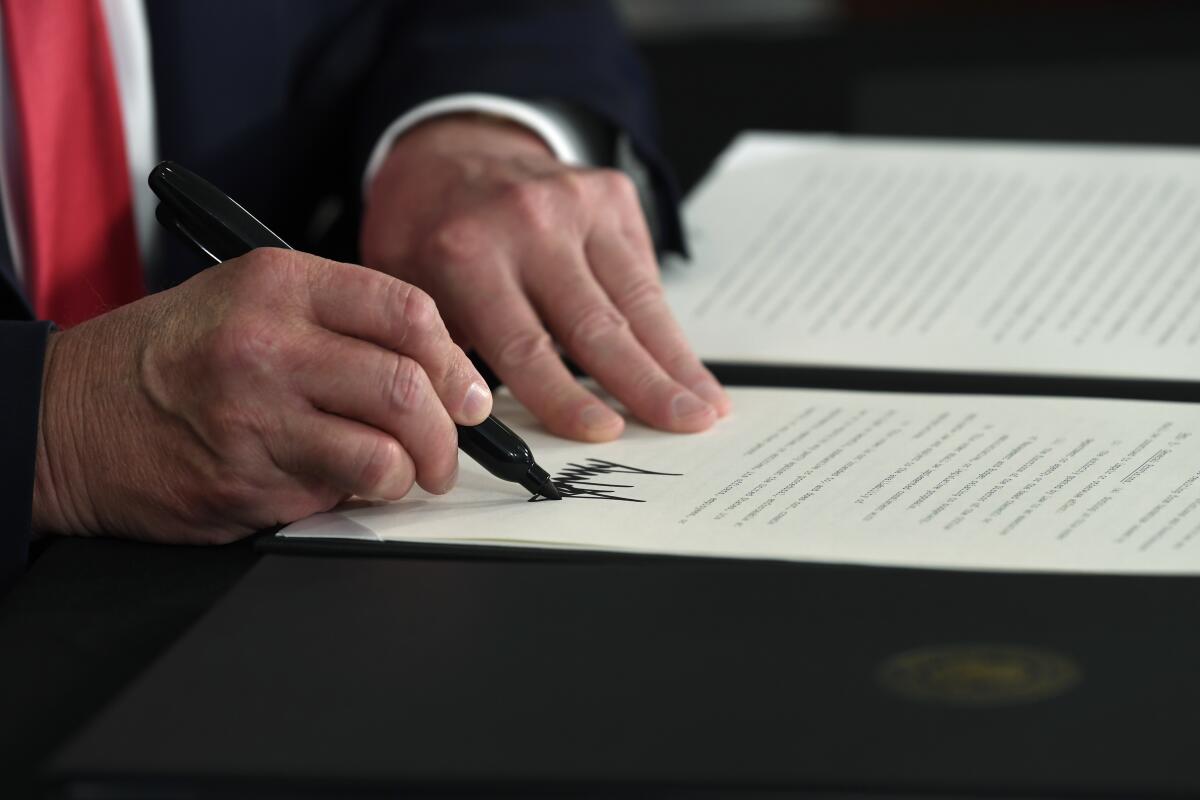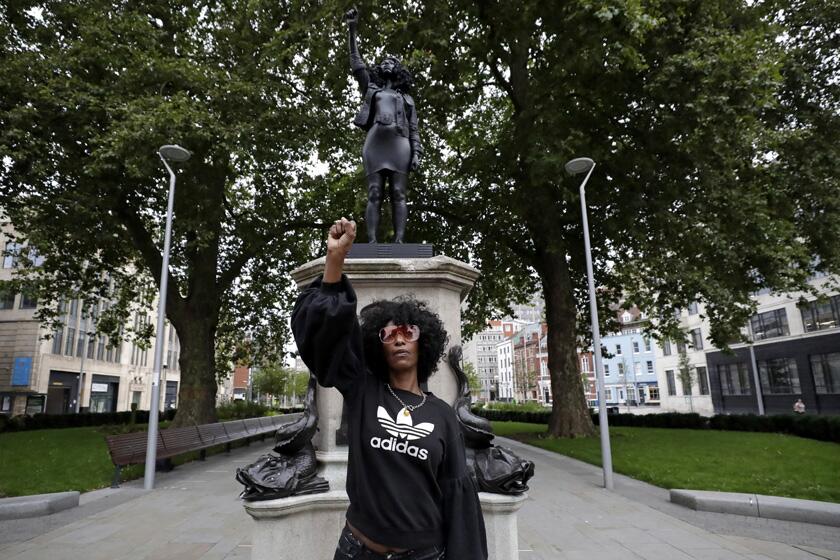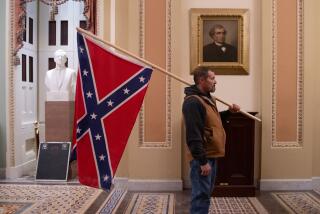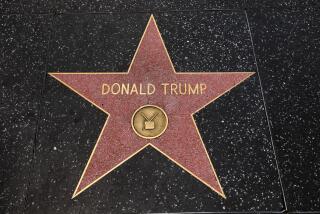Column: Trump trolls us on his way out the door with his garden of heroes plan

It is fitting that a presidential administration that has relentlessly trolled the world of culture — say, by repeatedly trying to eliminate the National Endowment for the Arts — would, in its final days, troll it some more by issuing an executive order to create what would amount to the world’s most absurd sculpture garden.
Back in July, after Confederate monuments and other statues were toppled during the civil rights uprisings in the wake of George Floyd’s death, President Trump issued an executive order to construct a National Garden of American Heroes that would serve as a “monument to our country’s greatness.” This would include statues to citizens who “made substantive contributions to America’s public life or otherwise had a substantive effect on America’s history.”
Among the whiplash-inducing list of honorees were Betsy Ross, Thomas Jefferson, Gen. George S. Patton Jr., Martin Luther King Jr., Billy Graham and Antonin Scalia. The list included not a single Indigenous person, Asian American or Latino. In addition, the order specifically mandated that statuary be “lifelike or realistic representations” — specifically forbidding “abstract or Modernist representations.”
It might as well have been titled “Make Monuments Great Again.”

Not one to leave dumb enough alone, the Trump administration followed that order with another on Monday that supplied a complete list of historical figures to be honored in his garden (whose location remains unknown). Never mind that this is not how communities build monuments in the 21st century. (The process is far more collaborative, far less top down.) And never mind that President-elect Joe Biden will likely undo the order within minutes of landing in the Oval Office.
Certainly, Trump’s list of 244 “historically significant Americans” for the National Garden reads like a farcical troll.
The requisite founding fathers, military leaders and frontiersmen mingle with civil rights activists and entertainers. There is Sam Houston and Whitney Houston, Susan B. Anthony and Elvis Presley, Sacagawea and Kobe Bryant, Thomas Edison and Steve Jobs, Harriet Tubman and, yes, Alex Trebek. Also on the list: Nellie Gray, the anti-abortion activist who founded the March for Life; George P. Mitchell, the “father of fracking” (go, pollution!) and Christopher Columbus, who never set foot on land that would become U.S. territory.
Shouldn’t public monuments have public input? In the George Floyd moment, artists and designers are changing the nature of monuments and the histories they honor.
The list is savvy enough to leave off Confederate leaders. Though it partly makes up for that by including Junipero Serra, the Spanish friar who helped establish California’s mission system (and a figure who has been the target of activists who have pointed to his role in decimating the region’s Indigenous populations). It also includes Andrew Jackson, the 19th century U.S. president who opposed the abolitionist movement and signed the Indian Removal Act, resulting in the forced relocation of an estimated 100,000 Indigenous people — a journey that resulted in the deaths of thousands.
Trump’s order was greeted with jeers. (“ALL THE STATUE IN THE NATIONAL GARDEN OF AMERICAN HEROES, RANKED,” tweeted New York Times film critic A.O. Scott.) But it speaks volumes about the ways in which Trump has shown that he actively disdains culture while deploying it as a weapon too.
I extracted all of the artists, architects and designers from the greater list to see what the administration’s thinking was in relation to my areas of coverage. It comes to 14 people — all of them male, almost all of them white, only three of them born in the 20th century.
They are:
- Photographer Ansel Adams (1902-84)
- Illustrators John James Audubon (1785-1851), Norman Rockwell (1894-1978), and Theodor Seuss Geisel, a.k.a. Dr. Seuss (1904-91)
- Early American painters Gilbert Stuart (1755-1828), who was known for his portraits of George Washington, and Charles Wilson Peale (1741-1827)
- John Singer Sargent (1856-1925), an American artist who, curiously, was not only born in Europe (to American parents), but spent the vast majority of his life there
- Pierre Charles L’Enfant, the French-born civil engineer and designer who laid out Washington, D.C.
- Architects Cass Gilbert (1859-1934), who designed the U.S. Supreme Court Building; John Russell Pope (1874-1937), known for the Jefferson Memorial; Thomas Ustick Walter (1804-1887), who oversaw major expansions at the U.S. Capitol building; and Henry Hobson Richardson (1838-1886), the man who helped introduce Romanesque Revival in the U.S. and had a penchant for dressing like Obi-Wan Kenobi
- There is also the rather ironic inclusion of Frank Lloyd Wright (1867-1959). Though he didn’t embrace the label of Modernist, he created buildings that certainly embodied its principles and helped seed the movement.
- The lone non-white person on the list is Carl Gorman (1907-98), a Navajo artist who served as a code talker during World War II and would later have a museum dedicated in his honor at UC Davis.
For the most part, it’s a traditional bunch, promoting historic European forms over everything else — much like the executive order the president signed early last year, which promoted Classical styles of architecture for federal buildings, a style that, as I noted in a story about the Capitol building published earlier this month, has some unsavory connections to white supremacist traditions in the U.S.

It can be easy to make fun of Trump, on his way out the door, for the zip, zilch, nada he has contributed to the cultural arena: His repeated attempts to take down the NEA, which not only failed but resulted in Congress throwing a bit more budget its way. His refusal, throughout his administration, to attend the Kennedy Center Honors. His track record in awarding the National Medal of Arts, which has been sporadic, and at times been used to honor vocal supporters (like Jon Voight and Toby Keith). And a White House events schedule that has been bereft of cultural programming. (Unless you count that time that Kid Rock and Ted Nugent showed up for dinner and posed for mocking selfies under a portrait of Hillary Clinton with Sarah Palin.)
But underlying all of these failures is a narrative that keeps getting repeated — about culture that is worthwhile and culture that isn’t, about what is American and what is not. The Trump administration has framed the American narrative as one that belongs almost exclusively to white men — Trump, after all, once referred to Confederate monuments as part of “our heritage” — where the best of American culture can be found not in the multicultural present, but in a mythical European past.
It’s a story that has resonated: Cue a Capitol riot with Confederate battle flags.

As historian Greg Grandin wrote in “The End of Myth: From the Frontier to the Border Wall in the Mind of America,” about Trump’s plans to build a border wall spanning the entire Mexican border, “the point isn’t to actually build ‘the wall’ but to constantly announce the building of the wall.”
Trump will never build his garden. And future federal buildings are unlikely to all be designed in a Neoclassical style. But the ideas this administration has surfaced — ideas rooted in the darkest aspects of U.S. history — remain very much alive. Trump is leaving office and probably taking his garden with him. His ideas, unfortunately, will be sticking around for a long time.
As a mob of Trump radicals smashed windows and invaded the Capitol, a building whose idealized narratives of liberty and democracy rest on the labor of slaves.
More to Read
The biggest entertainment stories
Get our big stories about Hollywood, film, television, music, arts, culture and more right in your inbox as soon as they publish.
You may occasionally receive promotional content from the Los Angeles Times.









